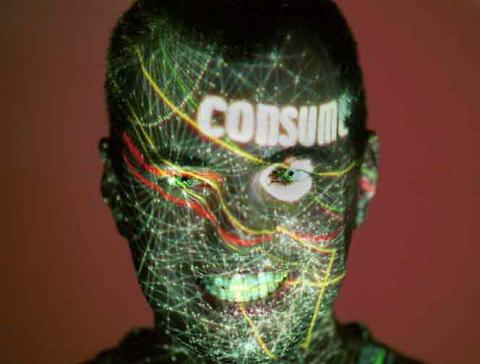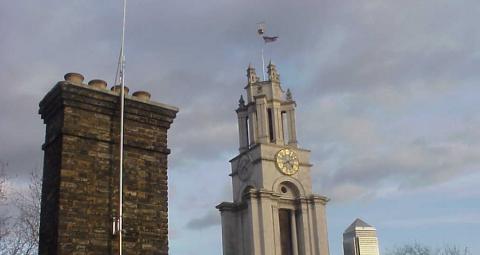Network Commons: dawn of an idea (Chapter 1, part 2 - Draft)
Good ideas often pop up at the same time at various points on the Earth, they just seem to be in the air. And so it came that around the year 2000 at different points on the globe wireless free community networks were started: Consume.net in London, New York Wireless, Seattle Wireless and Personal Telco, in Portland Oregon, were among the first wireless community networks based on Wireless LAN, or WLAN. Nobody really can say which one came first. I have been lucky to experience the development of Consume and free2air.org in London from a close encounter. Therefore, in this chapter I will tell the story of those networks.
But before I go into the details of this story, it is worth remembering a bit how things were back then. Today, when the debate shifts to a topic such as so called digital natives many young people seem incapable of comprehending that there are middle-aged people like me who have spent a large part of their adult life on-line. I had my first computer in 1985, whereby I should say we, because it was a shared computer between my then girl friend and myself. In 1989 it was followed by two new computers. She got an Amiga 2000, and I got a pre-Windows PC. So I spent a good time learning key commands for the DOS version of Word, while my partner could do wonderful graphical stuff on her Amiga. We could even digitize video, change every single image and turn it into a loop that could be played out and recorded to tape. While I was envious of the slick graphical interface of the Amiga, my PC soon learned a new skill, communication with other computers. That was when the whole on-line fun started.
Actually, we had to overcome a few obstacles first. In Europe, computer modems at the time – around the late 1980s to the early 1999s - had to be licensed by the national Post, Telecommunications and Telegraph company (PTT). This made the stuff prohibitively expensive for many. But we found a workaround. We traveled to West-Berlin and there, in a store called A-Z Electronics, we could buy a 2400 baud modem on the cheap. This modem could be legally sold because it had one cable missing – a loophole in German law according to which it was legal to sell unlicensed equipment if it was not in a state to be used. After we smuggled it back to Vienna, we soldered the cable and connected the modem to the telephone end-connection-point. Franz Xaver, a friend and artist-engineer, had to help to solve issues with the arcane Austrian telephone system. Another friend brought a pack of diskettes and we installed Telix, a program for communicating with a bulletin board systems (BBS).
The BBS world was like a testing ground for virtual communities where certain types of behavior could form. This could be elements of a netiquette, but also an understanding of what it means to be on-line in the first place. Stories about early on-line communities by author such as Sandy Stone1 and Howard Rheingold2 describe how these communities, some of which go back to the early 1970s, foster social (or anti-social;-) behavior.
First artistic experiments with “Art and Telecommunication”3 began in the late 1970s. The Canadian artist Robert Adrian X, who by then was living in Vienna, started an artist's conference board called Artex on a proprietary network in 1980. Fellow artist Roy Ascott described in vivid terms how it felt to be on-line and engage in real-time synchronous communication.
"Over the past three years I have been interacting through my terminal with artists in Australia, Europe and North America, once or twice a week through I.P. Sharp's ARTBOX. I have not come down from that high yet and frankly I don't expect to. Logging in to the network, sharing the exchange of ideas, propositions, visions and sheer gossip is exhilarating. In fact it becomes totally compelling and addictive." (Roy Acot 1984, quoted in Grundmann 1984, p. 28)'
Similar feelings have been shared by almost everyone since who first experienced an always-on network connection. But let's return to the BBS world, which could be quite wild at times. Artists-hackers such as Toek from radio art and performance group DFM circumvented the fact that those systems did not really have graphical interfaces by creating a log-on page with flashing and blinking ASCII animations. Communications in those systems were uncensored – apart from the curiosity of the maintainer of the system – and sometimes one could encounter, without looking for it, cracked software or literature such as the “Hackerfibel” by the Chaos Computer Club, or the Anarchist Hackers Cookbook, or The Temporary Autonomous Zone by Hakim Bey; one could also find software for war-dialling and similar things bordering on what was legally permissive. Thus was created the myth of the Internet as a kind of large DIY bomb-building workshop.
This is a pretty persistent myth by the way, but has maybe more to do with the criminalization of hacking by the US secret services who seemed to be intent on demonizing an activity that many of those involved understood primarily as curiosity, research, interest, gaining new knowledge. When the Internet was opened up for public usage, it seemed to get populated very quickly by all kinds of creative spirits. In 1995, when I had, through work, my first always on “broadband” Internet, the web seemed to consist primarily of artists, anarchists, trade unionists, multinational and non governmental organisations, campaigners for the environment, workers' rights and indigenous groups, as well as the occasional commercial web page of a forward looking company and the standard setting physics department homepage which has been immortalized by artist Olga Lialina with this work "Some Universe": http://art.teleportacia.org/exhibition/stellastar/. Olga Lialina has also collected “Under Construction” signs such as this one, another charming aspect of the early web:

While the on-line world was colorful and intellectually stimulating, Internet access was not that cheap at all at the time. We looked with envy at the US, where local calls were almost free. In Europe you had not only to pay the costs of a provider, but also the costs of the call for every minute you spent on-line. As the 1990s progressed, the modems got faster and maybe telephone provider rates a bit cheaper, but the situation remained fundamentally the same, except in those rare instances, where people came up with inventive solutions.
Cheap Broadband for the Masses: Vienna Backbone Service
In Vienna, Austria, the media artist Oskar Obereder started an Internet service provider almost by accident. With some art school friends, Obereder had launched “A Thousand Master Works”, a project where artists produced multiples which were sold via a poster. Soon, the poster proofed an inefficient method of keeping the offerings up to date. Obereder created a data base and together with some other artists, hackers and the editors of music magazine Skug brought the server on-line, as a web based ordering system. The same technology also supported Skug's data base of independent music. This machine had to be online 24/7, so Obereder and Skug had to get a leased line. In order to share the cost, they distributed internet access throughout the loft-spaces in a former furniture factory where lots of other artists and creative people worked. Everyone who connected to this cable-bound ad-hoc net got the buzz of an always-on Internet and Obereder inadvertently became a provider.
Working together with a small ISP, AT.net, Obereder and colleagues found out about a technology that was coming from California, brand new, and allowed normal copper telephone lines to be used for broadband Internet connections. This was called DSL, and when they first contacted the manufacturer they told them to get lost, because they only sold to telecom providers. Finally, the Austrians got hold of a few modems and started laying the groundwork for what would become Vienna Backbone Service (VBS). This network was offered by three small ISPs as a collaborative effort, but it was also “provided” by many of its first customers who were hosting network exchange services in their cupboards.
Because of the “creative milieu”4 in which Obereder existed, he knew many artists and techies or combinations of those, who had high bandwidth needs and some technical skills. As he by now had founded a company, called Silverserver – later shortended to Sil – they had found out that there was a special type of telephone line that you could rent quite cheaply from the incumbent, and over which you could run DSL. Moreover, the cost was dependent on the distance from the next exchange. Silverserver started finding friends, who were also customers, who lived next to an exchange. In this way, they found a foothold in many Viennese districts, from where they could spread out organically, offering always-on broadband at a tenth of the price, initially, of the incumbent.
In 1998 the workshop and conference Art Servers Unlimited brought together about 40 artists, hackers and activists of all kinds at London's Backspace and the ICA. Obereder was presenting the model of VBS and James Stevens caught an earful of it. What he mainly got out of it was that you could grow a rather large network in a decentralized way, by a collaborative method that involved people taking over responsibility for a node.
Consume – the culture of free networks
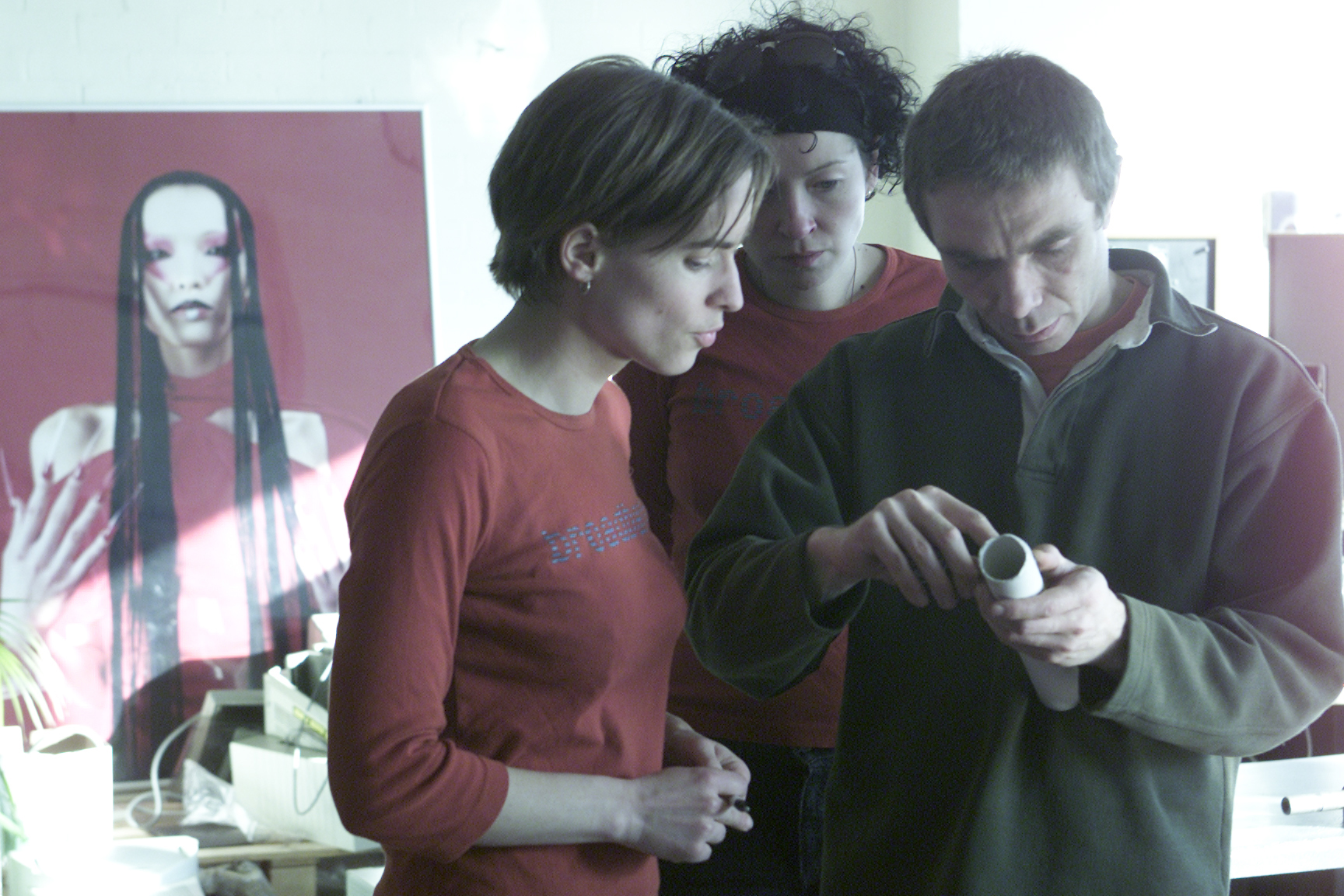
Free Networking as social mechanism: Consume workshop with Manu Luksch, Ilze Black and Alexei Blinov, probably 2003
James Stevens and Julian Priest found another inspiration for their “Model 1” (see chapter 1) through the way in which in a particular neighborhood and social environment WiFi was used to share a leased line Internet connection. At the turn of the millennium, James Stevens and Julian Priest had "worked for a decade almost in multimedia, making CD ROMs and websites, running around... then we decided to give it a try, and concentrate on doing more altruistic work.”5
Both had their offices in a special corner of Southwark, the London borough just south of the Thames, in Clink Street, in a small warehouse, directly on the riverside, called Winchester Wharf. Today, oh irony, the ground floor is occupied by a Starbucks. Adjacent to it there were other warehouses, converted into offices and studios for various creative outfits, from record labels to web and multimedia companies. In Winchester Wharf, the web company Obsolete and the Internet cafe Backspace enjoyed a few years of happy coexistence. Obsolete had become successful quickly by making web-pages for Ninja Tune and other record labels located in the same building. After record companies followed some blue chip companies such as Levi who were intent on having a cool, young image. But James Stevens had already opted out at that time.
So he founded Backspace (http://bak.spc.org/), a place at the ground floor, with one window almost on water-level when the tide was high. Fittingly, the homepage of Backspace showed (and still does show) a graphical animation of the river Thames with the web-sites hosted by Backspace floating like half sub-merged buoys in the river. Descriptions of Backspace it as an Internet cafe or gallery just show the ineptitude of common language to describe what it was. It was a hub where people with all kinds of ideas – whether they were related to the Internet or not – came together to talk, organize, share. Backspace was a crucible of London's net art and digerati, where events such as the legendary "Anti with E" (http://www.irational.org/cybercafe/backspace/) conferences and lectures took place. Backspace also became quickly known for its regular live-streaming sessions, at first mainly radio, later also videos, with Captain Gio D'Angelo often in command6.
That was only made possible, because Backspace shared a leased line with Obsolete, who were just upstairs. The other small outfits in the area, on the same street but not in the same building, also wanted a share in the bandwidth Bonanza. At first some sort of Grey area solution was considered, like finding a way of connecting buildings via Ethernet, but that turned out to be impossible, unless one broke the law or dug up the street, legally of course, as a provider company. At some point, someone must have stumbled over WiFi or Airport, as the version promoted by Apple was called. A lot of people in Clink Street were designers and thus Apple users who at the time were the first major consumer computer company who supported WiFi through “Airport” as they called it (See History of WiFi, by Vic Hayes et al 7).
The creative cluster of artists, designers, musicians and entrepreneurs experienced the benefits of broadband and also the laws of network distribution. As Stevens and Priest noted, the maximum bandwidth available is only relevant at peak times, when everybody was on-line, checking into the system, or after work, when people played games or watched videos. Otherwise, the 512K connection, which today would not be considered broadband anymore, was giving everyone enough space to live, listen to music, build web-pages or even play on-line games. But the bandwidth paradise on the Southern shore of the Thames was not to last.
Whinchester Wharf was sold as part of a general regeneration drive of the Southern river bank, at a time when Tate Modern was opened and the whole area underwent a wider transformation. “Between us, we both had an axe to grind when Backspace was closed, we sat together and talked about it and thought it was a good moment to put into practice some of the ideas that we have hatched and some of the things that we have experimented with,” remembered James in 2003. In late 1999, they organized a first workshop to start building Consume, in the offices of I/O/D, one of a web of companies and art groups in the area. For James Stevens, it was ffrom the beginning a "social thing". "The idea that came out was much more straight forward than it looks now, but it was interlinking locations where people work and live using this wireless stuff. We did it already across the street, so that sort of scale where we had a grasp.” (James Stevens, interview with the author, 2003).
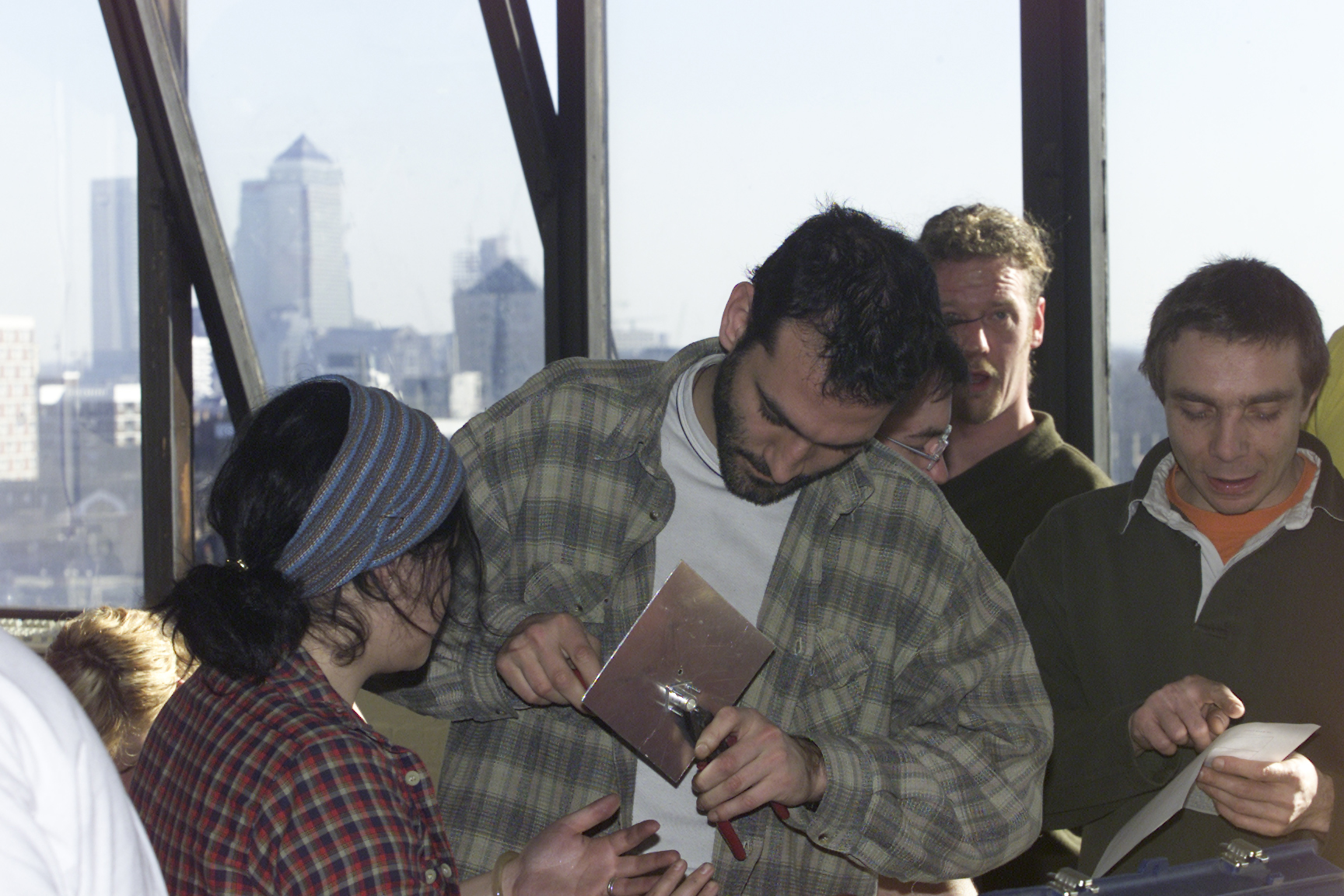
Consume workshop at the studio of AmbientTV.NET, London circa 2003
I received this invitation and remember that I was electrified (although it turned out that I could not participate in that first meeting). I knew that James Stevens was on to something. As he later put it in his own words, "it was on the cusp of a wave of awareness that was sweeping around, also economically we were in a funny state, in a kind of decline of the swell after all of that gluttony of that Dotcom shit." Within the space of a few years the Net had been completely transformed from a colourful space dominated by various leftist and creative types to a place apparently ruled and defined by multinational corporations.
The early WWW had generated a lot of enthusiasm about free speech and possibilities of political self-organisation. It was seen as an electronic Agora, a place where democracy could be reinvented through participatory processes, electronically mediated. Yet in the eyes of the media, all attention was devoted to Internet startups such as Netscape and Amazon who made billions with their IPOs. Ideas about freedom of speech and creative expression, held dear at places such as Backspace, were completely omitted in public discourse. But in late 1999 the stock market boom had started to flounder and in April 2000 the Nasdaq collapsed. Suddenly, the pendulum swung back and ideas about freedom of speech and political self-organisation came back. The call for the first Consume workshop was met with “a phenomenal response” according to Stevens. The question they asked themselves was: the technology had shown to work in a relatively confined area. Could it be made to work over a mile or two? Could different areas be connected into a Wide Area Community Network? Stevens:
. There was a momentum there, in that way, because it grasped peoples attention and got them to come out, literally, just physically to turn up, gather at a meeting, and really, the second meeting that we had, we built nodes. It was really just like as direct as that: physically turn up and do it; those who could handled the Unix side of it, which is not everybody, obviously.” (Stevens 2003)
This workshop must have been in the first half of 2000. What they were out to do, “was to provide ownership of network segments to self-provide those services and in addition to that do all sorts of node-to-node kind of benefits” explained Stevens. But the routing was soon found out to be a core issue to be solved. The nodes deployed in such a network had to mesh and this had to be automatic.
This was a grave problem in 2000, since the Internet by then had been thoroughly commodified, and junks of it handed over to companies, who could defined it as their "country" or Autonomous System, controlling the entry points of the network. This is called Border Gateway Routing Protocol and on such a technical level there is nothing to be said against it. However, it introduces a more leafy, hierarchical structure, which boils down to the problem of exclusive IP numbers in networks. Due to the cascaded nature of networks, with many layers, users in internal networks are often linked via a protocol called NAT. That means, that this router controls the connection to the world, while this node is visible to the world also through this gateway alone. In other words, there is no public visible route to this machine. If a lot of people who share their network connectivity via wireless have such a provider, the routing in the network becomes a problem. There are workarounds for that problem, but this is just one aspect of a protracted sequence of issues regarding wireless and routing. 8
At that point, in the year 2000, mesh networking technology was really in its infants. Through the launch of Consume, a lot of gifted people started to get interested in mesh networking and similar ideas. It is fair to say that community networks took mesh technology out of the military closet and turned it into a working technology (a story which continues today with great intensity and to whch i will return later in this book).
The way how Consume grew, initially, owed much more to the special "genius" of James Stevens than to any technology. "Genius", a term usually resevred for artists or sometimes also scientists, in this context refers to a social skill. James Stevens has a special way of “growing” projects, of initiating them, bringing them into existence but then letting them go their own way. Rather than becoming the leader and figurehead, he tries to initiate a self-perpetuating idea. Maybe this has also something to do with his past in the underground music and squatter scene in the 1980s. Politically, those social scenes were, if not explicitly anarchist, connected with a deep sitting social and artistic liberalism that I found to be much more entrenched in England than in any other country of which I know.
For Stevens and Priest it was a long term goal to “find an opportunity, within the legislation of radio spectrum, to use these domestic computer devices to interlink in a way that it was deemed possible to bypass the local loop” argued Stevens. For him, what became a priority was advocacy, “promotion of systems that create a mesh over the topography. […] You just have to propagate the idea or possibility or potential across the landscape.” And that's what happened in the years 2000 to 2002. While Julian Priest had to take a step back for a litle while for private reasons and because of moving to Denmark, James Stevens and a small but fast growing group of volunteers was building Consume, a self-propgating net. A Consume mailinglist and a website were launched. But the main mechanism for propagating the idea were workshops. There were a number of workshops in spring and summer of 2002, one at the studio of Manu Luksch and Ilze Black, another one at Limehouse Town Hall, which I remember vividly.
The workshops offered something for everyone. First and foremost, they gave people in a particular area the opportunity to meet and discuss the possinbilities of creating a local wireless community network. This involved the social side of getting to know other people in the area. This may not sound like much, but in London talking to neighbours is seen as something quite radical. The only apparently banal thing of "talking to neighbours" went together with exploring the city-scape for suitable locations for antennas and repeaters.
Those who were inclined to do so were building antennas, an activity that showed to be quite attractive for a diverse range of people. It is also something that turns the rather abstract idea of the network into something that can be literally grasped. Antenna building also involves learning about basic physics and the electromagnetic spectrum, which is something very useful in a world pervaded by electronic devices.
Other workshop participants turned to the software side of things. At the time, old computers were used as wireless routers. They were taken apart, reassembled, equipped with network cards, turned into Linux machines and then configured by usage of some bespoke experimental routing software. The issues that posed themselves with regard to routing and networking were publicly and hotly debated which, in my case, triggered a steep learning curve. This was a time when I started to gain knowledge of IP numbers, address spaces, NATing and port forwarding, and, last not east, routing protocols.

Screenshot of Consume Node Data Base of UK in text mode
As Stevens and a core group of supporters traveled up and down the country, workshoping, talking, advocating, Consume quickly developed a national dimension. Networks and nodes popped up all over the country. The vibrancy of Consume was based on the support it found by a wide range of people across the UK. Stevens advocated a model of de-centralised person to person communication, realized via self-managed nodes. De-centralisation was at the core of the idea, politcially as well as technologically. The network was not centrally owned and managed but came together as a resut of the activities of many independent and self-motivated actors. James Stevens at the time argued:
“Creating any sort of infrastructural layer on the landscape, in an environment or the community, that's something that has always been left to the councils or commercial entities, but this is something that can be pulled out from the ground at any level almost really. A school can just decide to put up an access point: utilize, redistribute, in order to legitimately pass the network that it has got from its council network and say its available throughout the school without any wires.” (James Stevens 2003)
Stevens wanted to demonstrate that large, infrastructural projects could be realised in a bottom-up manner, through processes of self-organisation and through the mobilization of social capital (rather than financial capital). This was only possible because Consume attracted some very gifted people, such as the Russian artist-engineer Alexei Blinov, founder of Raylab, later Hivenetworks; hacker-programmer-techies such as Jasper, who programmed the Consume Node data base, and BSD core developer Bruce Simpson; and network admin wizards such as Ten Yen and Ian Morrison. Other people who participated, such as Saul Albert and Simon Worthington, co-founder of Mute Magazine, could be described as non-commercial social entrepreneurs; their strength was also advocy, creating ideas of their own and pulling in people and resources; the same can be said of artists and curators such as Manu Luksch, Ilze Black and myself who, for a while, also belonged to the core of the London free network scene (I will dedicate a special chapter to art and wireless community networks later in this book). Another core participant was Adam Burns, who can claim to have had the same idea, more or less, by himself, and had set up the first wireless free network node in Europe, free2air.org.
You are Free 2 Air Your Opinion

Adam Burns and Manu Luksch explore skies over East London. Photo: David
While Consume had been an early project, as a really existing free network in London it had been preceded by Free2air.org. Free2air.org was the virtual flag flown by Adam Burns, of Australian descent. In his daytime job he managed firewalls of financial groups, in his spare time he had set up an omni-directional antenna on a building on Hackney Road, just above the Bus stop and the Halal Chicken shop. From there, everybody could pick up a signal who was in range.
"To my knowledge I am not aware of any other facility in Europe offering totally open network access like this. I do not want to know the name, the address, the credit card number, the colour of the eyes or hair of anyone who connects through to this network, that's unimportant to me. And I don't feel that this is a necessary requirement." (Adam Burns, Interview with Armin Medosch)
At the time of the interview, which must have happened in autumn 2002, Adam Burns claimed that free2air had been active since 18 months. Thus, from late 1999 or early 2000, Free2air.org, hosted by a machine called Ground Zero, offered free wireless Internet access to everyone passing through. Adam Burns had been involved with small ISPs in Australia in the early 1990s, when providing Internet access was done more out of ethical conviction than business sense. This background has inspired his keen sense of networking as a social project.
“Free2air is a contentious name, but one that I have chosen to use. Basically it has a dual meaning: once you establish such a network the cost of information travel is free. It's not a totally free service to establish, you need to buy hardware, you need computer expertise and so on. But the whole idea of ongoing costs are minimal. Secondly, what I liked about it is the plans for a distributed open public access network. It gets rid of the idea of a central ISP, in other words, globally around the world, when we are talking about the Internet or censorship or pedophiles hanging out, or bomb makers, there is a lot of concentration on what really goes on in networks. When you have got a lot of people passing information directly to each other its very hard to track down what information has and has not passed and how it got air. So there is a double meaning to free2air, it also means you are free to air your expressions without concern or problems in getting that message through.” (Adam Burns, 2002)
East End Net

an omni directional antenna by Consume, a spire and the towers of the financial center, East London 2002
Adam Burns became a central person in the London wireless scene around Consume and what came to be known as East End Net. The idea was launched to connect Limehouse Town Hall with the area around the office of Mute magazine at lower Brick Lane, and somehow to connect also Bethnal Green and central Hackney. That bit was also the place where I lived at the time. While the large version of East End Net never materialised, we had our local version of it, with a connection from free2air.org to the “compound”, a large workspace building for small industries at the bottom of Broadway Market in E8.
With AmbientTV.net's help, the connection was spread by wireless and wirebound through the building. For several years a community of changing size, from between 20 to 40 or 60 people, inhabited a chunk of the net. Due to the social composition of this area, a number of art projects using the free WiFi took place. I will turn to those projects at a later stage.
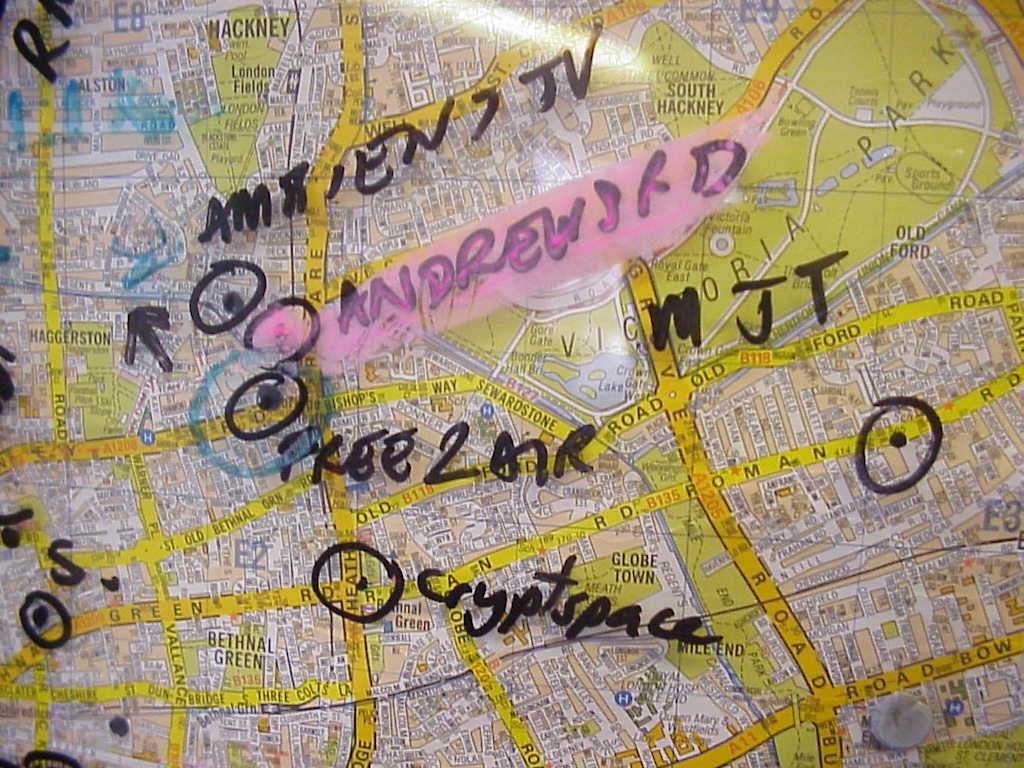
East End Net: The Original Map
While East End Net was never built in the way it was supposed to, the discussions and the focus that it generated was highly productive in a number of areas. Several lines of flight are taking off from this point, which all will have to be followed separately - so I'll just hint at some of those ideas in overview form. The hand drawn original map of East End Net was the starting point for a lot of ideas about mapping of wireless networks, but also ideas about communal map making as such. It was the time when the Open Street Map project began, as it was recognised that also something as complex as a map could be built in a decentralized way by unpaid volunteers.
Consume's NodeDB, as already mentioned, was a quite early and successful attempt at building a website that facilitates registering a free network node through a wiki-like functionality. The idea was that the database would not only contain technical information about nodes, but also additional information about services offered. In this way, the NOdeDB would become the focus of community development and of micro-ecologies of small business, art, culture, activism.
The communal building of a wireless mesh network over a large part of a metropolitan area also raised issues about ownership and responsibility. While, as we shall see, in Germany the discussion from the very start was dominated by anxiety about legal repercussions of sharing an Internet connection, in London the discussion was about the notion of the commons. It was through Julian Priest that I became introduced to the work of Elinor Ostrom who successfully contested the hegemony of the thesis of the Tragedy of the Commons - work for which she later received the Nobel price in economics. We started to discuss the implications of what it meant to treat the network as a commons and sought to find ways of affirming this status of the network commons.
For me, personally, two fundamental insights emerged from my involvement at the time. Through participating in workshops and talking to techies, I started to understand a bit more what happened behind the surface of the screen when one clicks on a web-page or sends an email. As I gained insight into how networks function technically, I experienced this as a form of empowerment. In my view, everyone should understand at least a little bit about how networks work. Why? Because networking is not just about moving around bits and bytes, it is about communication, freedom of speech, about democratric participation, the freedom to learn things. One big problem that we have in societies such as ours is that the division of labour imposed on us creates categorical separations between things that should be seen and understood as belonging together. Building and maintaining telecommunication networks is seen as a technical task but affects fundamental human rights and social issues. Thus, everybody should have at lest some idea about how it works, as they otherwise cannot meaningfully participate in Network Society.
Thus, as a grand thesis I would like to introduce here, I propose that the involvement of ordinary people in building a network commons has a profound emancipatory effect. In particular, as the process allows people to learn more about the structure and the functioning of the Internet, they gain a better understanding of what they can potentially achieve in societies and, no less im.portant, how to protect themselves from the harmful effects of information abuse by corporations and government. As people learn how networks work they can become teachers of the free network spirit. They will understand that they can become part of the network (and not only be useres of a service provided by a corporation or the state), and can bring to it their own specialisations and ideas. Through that, the idea of the network also gets enriched.
Thus, the second part of the thesis is that free networks contribute to the democratisation of technology. Conventionally, technology is considered to be developed behind the closed walls of research labs. There, gods in white (or jeans and black pollunder) develop the technologies of the futures, which the thankful people then consume as a commodity. The way in which wireless community networks function, that is, the development of cutting edge technology, is opened up to wider mechanisms of participation. This secon part of the thesis is almost confirmed already through the existence of a project such as the EU project Confine. Through the involvement of community networkers in shaping future technologies, those technologies become less elitist, less controlled by narrow commercial or security interest. The original peer-to-peer spirit of the net gets enhanced and made fit for the future in a network commons that is there to protect our democratic freedoms and rights.
Next, Chapter 2: Consume the Net - the internationalisation of an idea (watch this space ...)
- 1. Stone, Allucquère Rosanne. The War of Desire and Technology at the Close of the Mechanical Age. MIT Press, 1996.
- 2. Rheingold, Howard. The Virtual Community: Homesteading on the Electronic Frontier. MIT Press, 1993.
- 3. Grundmann, Heidi. Art + Telecommunication. Vancouver, [B.C.]: Western Front Publication, 1984.
- 4. I have written more extensively about this in Medosch, Armin. “Kreative Milieus.” In Vergessene Zukunft: Radikale Netzkulturen in Europa, 1., Aufl., 19–26. Bielefeld: Transcript, 2012.
- 5. James Stevens, interview with the author, June 2003, private notes
- 6. see article by josephine Berry http://www.medialounge.net/lounge/workspace/crashhtml/cc/23.htm
- 7. Lemstra, Wolter, Vic Hayes, and John Groenewegen. The Innovation Journey of Wi-Fi: The Road to Global Success. Cambridge University Press, 2010.
- 8. Corinna "Elektra" Aichele, a free networker from Berlin, has summed up those problems and possible solutions much better than I ever could in her book "Mesh - Drahtlose Ad-hoc Netze", Open Source Verlag, 2007
